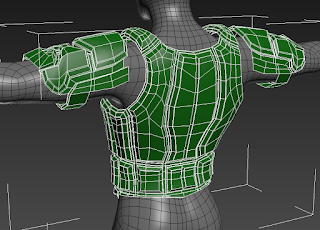I finished the textures for the William Tell armor. I had based the textures off of the weapon textures. I wanted them to match or at least go together. I know in the original concepts everything was in black and white, but I never ended really intended to have the textures stay black and white. The concepts were merely to show the armor type/look. The base mesh texture is a wireframe composite material from 3ds Max, so in game engine it will only be plain gray. I'm thinking that the wireframe look can be done in unity using a shader. As for animations, I've been using some animations from last semester and trying to edit it to my liking.
Monday, February 29, 2016
Monday, February 22, 2016
Finishing the Crossbow
Along with the armor, I felt that the crossbow could use a visual update. The previous crossbow wasn't bad, but it wasn't great either. I went for a futuristic look but also something eye catching. At the time that I was texturing I was thinking of an old project I did my first semester. It was a shooting game involving a lot of spiders. I based the textures off of that texture.
Inspiration for the crossbow texturing
Crossbow Bolt
Friday, February 19, 2016
Finished the Armor, Moving onto the Weapon
I finished the armor modeling. However, I had a lot of geometry that I felt that I could remove. In the hard surface modeling tutorial I watched, support edge loops were used a majority of the time. These loops helped with telling 3ds Max that the edge between the other two was a hard edge. Although these loops helped initially, this model is for a game, and geometry is limited, so I looked up trying to use smoothing groups on the model to achieve the same look but with less geometry.
I managed to use smoothing groups effectively. I was able to export my file into Mudbox while keeping the hard surface look that normally would have been smoothed out. I was able to optimize my model. Below is a comparison. Utilizing smoothing groups, I was able to cut my poly count by roughly 2500 while having little to no change in appearance.
Video on using smoothing groups for exporting in Mudbox.
I managed to use smoothing groups effectively. I was able to export my file into Mudbox while keeping the hard surface look that normally would have been smoothed out. I was able to optimize my model. Below is a comparison. Utilizing smoothing groups, I was able to cut my poly count by roughly 2500 while having little to no change in appearance.
Updated model: 3275 polygons (Smoothing groups) (Top)
Previous model: 5792 poly(Edge loops) (Bottom)
Friday, February 12, 2016
Modeling out the William Tell Armor
Update:
After watching the video, I got a good idea and concept of hard surface modeling. I modeled out a couple of pieces.
After receiving some critiques on my concepts, I can start working on modeling out the armor for the William tell armor. I decided to try to take elements of the concepts and model out armor pieces. I'm trying to maintain the style but give it a futuristic look to it. It's a little challenging because I never really liked modeling out hard surfaces since I've had difficulties with it in the past; I prefer organic modeling. I looked at some tutorials to see if I can get a better understanding of hard surface modeling.
After watching the video, I got a good idea and concept of hard surface modeling. I modeled out a couple of pieces.
After receiving some critiques on my concepts, I can start working on modeling out the armor for the William tell armor. I decided to try to take elements of the concepts and model out armor pieces. I'm trying to maintain the style but give it a futuristic look to it. It's a little challenging because I never really liked modeling out hard surfaces since I've had difficulties with it in the past; I prefer organic modeling. I looked at some tutorials to see if I can get a better understanding of hard surface modeling.
Hard Surface Essentials.
Monday, February 8, 2016
Creating the Concepts
After doing research. I created several concepts for the William Tell character. I used the real-life references as my influence. I focused more on the type of armor and design of the armor than the color. Also, I realized that we want a futuristic look, but that can be accomplished through the model/texturing.
Thursday, February 4, 2016
Researching Armor References
The art team is doing a bit of back peddling. We're starting with coming up with concepts for the crossbowman/rocket man. We had some concept art from the previous semester, but a lot of them weren't used. Also, there wasn't much direction when we created the original concepts. By redoing this step, hopefully we'll have a more streamline art style. I'm focusing on the William Tell character, and primarily researching armor from that era. Then once I have some good references, I can start making concepts. Here are several examples I found.














Subscribe to:
Comments (Atom)














